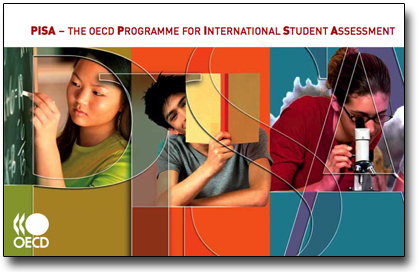Gender Differences in Secondary Education

 The Programme for International Student Assessment
The Programme for International Student Assessment
PISA is the Organisation for Economic Co-operation and Development ’s Programme for International Student Assessment, which evaluates the quality, Talk:Gender Equality and efficiency of school systems in some 70 countries. Together, these countries make up nine-tenths of the world economy.OECD (2010), PISA 2009 at a Glance, OECD Publishing, p.3 Starting in 2000, the PISA has been publishing a report every three years, which provides information about the key skills and competencies in reading, mathematics and science of 15-year-old students. PISA 2009 featured data for around 28 million students.Ibid.
Equity in education has social, moral and economic advantages. Recent PISA studies have shown, however, that a distinct Gender Gap is present amongst 15-year-olds, just as they are coming to the end of their compulsory education and beginning to participate in society.
Findings and Implications
Reading
PISA results show that there is a significant gender gap between the sexes with regards to reading. In every country represented, girls outperform boys in reading. Girls scored significantly higher than boys and in some OECD countries, girls were up to a year ahead of boys in their reading skills.
The widest gender gaps were recorded in Albania , Bulgaria and Lithuania as well as in some Nordic countries. The proportion of boys with the lowest level of reading proficiency was also much higher than that of girls.
The study also found that, in almost every country, girls read more than boys for enjoyment, particularly fiction and magazine whilst boys are more likely to read newspapers and comic books.
Implications
These results have major implications for education. The underperformance of boys appears to be a serious issue in all countries. Literacy proficiency is a fundamental aspect of learning and education policy will need to address male underachievement in order to close this gender gap.
Reading habits would suggest that one of the reasons behind male underperformance is that girls associate more pleasure with reading. Policy makers will therefore need to develop engagement and enjoyment of reading materials in order to improves boys’ proficiency levels.
Mathematics
PISA results show that boys outperform girls in mathematics in 35 of 65 countries. In five countries girls outperform boys and in 25, there is no significant difference.OECD (2010), PISA 2009 at a Glance, OECD Publishing, p.22 OECD countries are where boys perform better than girls in mathematics, for example, in Belgium , Switzerland , the the United Kingdom and the Gender Equality in the Gender Equality in the United States of America of America of America. The gender gap is however, less significant than that which exists in reading skills.
Implications
The results from the study indicate that levels of mathematics skills are not a gender-related problem since in many countries there is no noticeable difference and in some countries, girls outperform boys. What this does suggest is that the stereotyped notion that girls are “not good at numbers” perhaps has an effect on performance and enjoyment of mathematics.Ibid. Some policy orientation to this issue in countries where boys are outperforming girls could result in a closing of the gap.
Science
Results show that science is the domain where the difference between the sexes is at its lowest. In 33 out of 65 countries there is no significant difference between girls and boys, girls outperform boys in 21 out of 65 countries and boys outperform girls in 11.OECD (2010), PISA 2009 at a Glance, OECD Publishing, p.28 In OECD countries, boys and girls generally have the same competencies in science. Countries where girls outperform include Middle Eastern states such as Jordan , the United Arab Emirates and Qatar .
PISA 2006 gave a more thorough assessment of gender differences in sciences and showed that girls are stronger at identifying scientific issues and life sciences whereas boys are better at physics and chemistry and at explaining phenomena scientifically.
The same survey also asked students about their aspirations of having a career in science. PISA noted a more marked difference here. Three times as many boys as girls saw themselves as engineers or technicians or as working with computers or in physical science, while more than twice as many girls as boys saw themselves in a career in health, the life sciences or nursing, the so-called “caring” professions.OECD insights, “Great Expections: girls in school today”, March 2011
Implications
The findings for science indicate that performance is not linked to gender, despite the face that traditional stereotypes might suggest otherwise. Indeed, science is a domain where policies focusing on gender equality can be considered a success.OECD (2010), PISA 2009 at a Glance, OECD Publishing, p.28 Nevertheless, further down the line, in tertiary education or in their careers, women continue to be underrepresented in science and technology, particularly in the higher-paying jobs in the field such as engineering. Given the results obtained in PISA 2006, in the domain of science and technology, girls are perhaps excluding themselves from the better-paid jobs from the early age of 15.
Conclusions: fighting the gender gap
Historically, education policy has been focused on girls’ underachievement and access to education. PISA studies show that in many countries, policy has evidently been a success in combating female underperformance, for example, in the case of science. Educators are now faced with what has been termed the “The Boy Turn” see for example, Weaver-Hightower, “The “Boy Turn” in Research on Gender and Education”, 2003, as reading has become a gendered activity in which boys are lagging behind.
Education policy needs to focus on reducing the gender gap in literacy and improving young male performance. To do so, teachers need to be aware of the differences and provide new strategies and support for boys, for example, appealing to their interests, widening choices and trying to engender a more positive approach to reading. These kinds of strategies would also need to involve the family and society more widely.OECD, “Equally prepared for life?: How 15-year-old girls and boys perform at school”, 2009 Literacy is a pivotal part of education and key to academic, societal and career success, therefore, an informed response to the growing gender gap in reading must be implemented. Similarly, educators need to encourage and develop girls’ interest and confidence in mathematics so as not to limit future career choices. A close interrelationship exists between subject interest and learning outcomes, therefore, varying habits, aspirations and interests of young females and males may have far-reaching consequences. OECD, Literacy Skills for the World of Tomorrow, PISA 2000, ch. 5, p.161
See also
Access to Education
Global Campaign for Education Gender Gap Wage Gaps Between Men and Women Gender Differences in Career AmbitionsReferences
External links
PISA 2003 results
PISA 2000 results
Equally Prepared for Life?: How 15 year old girls and boys perform at school


